No cameras! Iconic spots with a photo ban.
In a world where most of the things revolve around Instagrammable moments and the pursuit of the perfect travel snapshot, it will be disheartening to note that certain renowned landmarks don’t allow photography. In short, they have strict restrictions in place with regard to photography within their premises. If you were not aware about these places, here are some of the most famous attractions globally where capturing the moment on camera is not just discouraged; it’s strictly prohibited.
Taj Mahal, India
Although the Taj Mahal serves as an enduring symbol of love and architectural brilliance, visitors are prohibited from taking photographs inside the tomb. Stringent security measures are in place to ensure that nobody breaks this rule, and preserve the sanctity of the mausoleum.
Eiffel Tower, Paris
Surprisingly, the Eiffel Tower, a global icon and one of the most photographed structures, restricts photography after sundown. Once illuminated, the tower is considered an art installation, falling under copyright protection. Consequently, sharing pictures online or for commercial purposes is strictly prohibited.
Kumsusan Palace of the Sun, Pyongyang, North Korea
In the highly confidential world of North Korea, strict security measures, including a comprehensive body inspection and the leaving behind personal belongings, are enforced upon entry to the Kumsusan Palace of the Sun. Taking photographs inside the mausoleum, where the remains of Kim Il-sung and Kim Jong-il lie, is strictly prohibited.
The Alamo, Texas
This historic site, representing a significant moment of heroic resistance, restricts photography within its premises during guided tours. Guests are also required to respect the place and bear in mind to speak quietly and taking off their hats upon entering.

Westminster Abbey, England
A crucial part of British history, Westminster Abbey permits photography solely from its exterior. The restriction on taking pictures inside the premises is intended to maintain the sacred ambiance, while professional photos can be obtained by downloading them from the church’s website.
Sistine Chapel, Vatican City
Despite the completion of the restoration project by Japan’s Nippon Television Network Corporation two decades ago, photography remains strictly prohibited in the Sistine Chapel. The exclusive rights granted during the restoration are still enforced, making it a no-camera zone.
Presidential Palace, United Arab Emirates
Due to security reasons, photography and videography are strictly prohibited at the Presidential Palace. This ban extends to other government buildings and military installations. Taking pictures of individuals without their permission, especially women on the beach, can lead to imprisonment and fines.
Valley of the Kings, Egypt
The Valley of the Kings, a rich repository of ancient tombs and monuments, rigorously upholds a no-photography rule. Those trying to clandestinely bring cameras into this archaeological marvel may incur fines, underscoring the significance of safeguarding this historical site.
Uluru Kata-Tjuta National Park, Australia
Ayers Rock, located in the Uluru Kata-Tjuta National Park, holds cultural significance for the local Aboriginal population. Photography of certain sacred sites, ceremonies, and objects is strictly prohibited, with professional photographers barred from entering the park.






